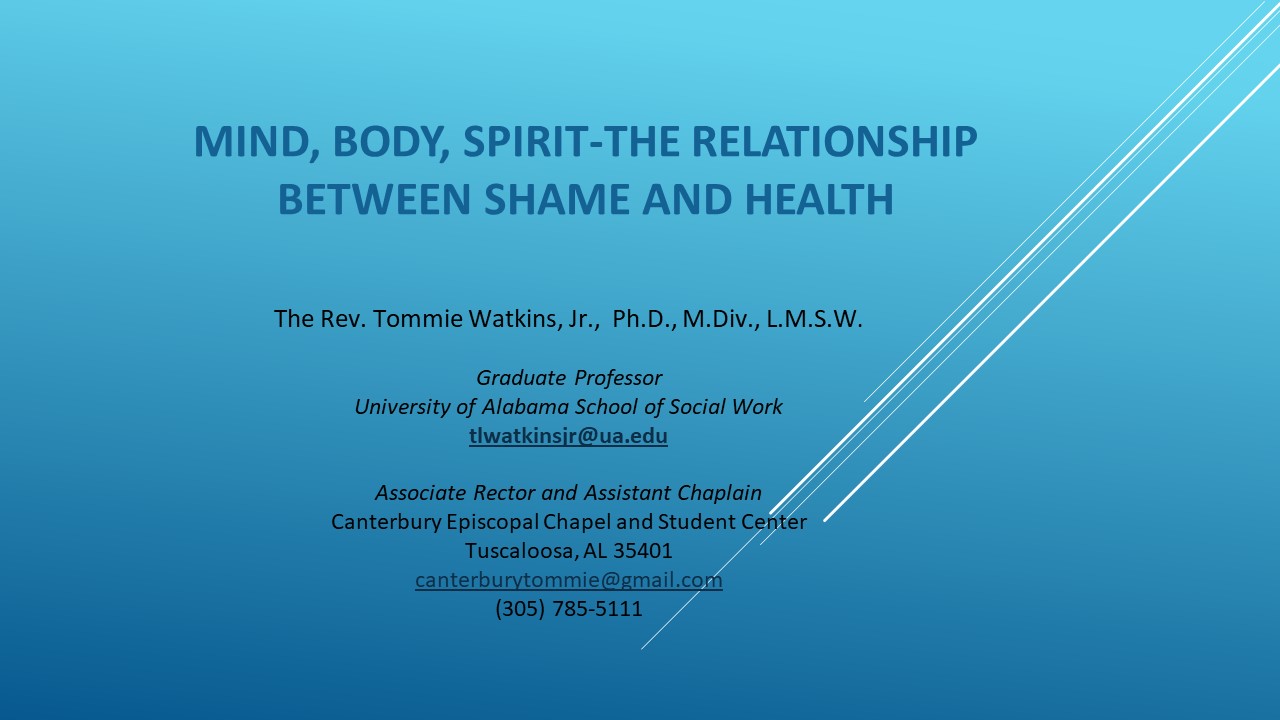Webinar: Mind, Body, Spirit: The Relationship Between Shame and Health

Facilitated by Rev. Tommie Watkins, PhD, MDiv, LMSW
Graduate Professor
University of Alabama School of Social Work
Associate Rector and Assistant Chaplain
Canterbury Episcopal Chapel and Student Center
February 21, 2018
Other Trainings
- Webinar: Providing Gender Affirming Care and PrEP in a Student-run Free Clinic
- Webinar: Intersectionality & Communication
- Webinar: Unmasking Bias: Confronting Sexism in HIV Treatment and Prevention
- Webinar: Using Adult Learning Principles to Create Effective Training
- Webinar: Effectiveness of an Educational Intervention at an Academic Medical Center to Reduce Stigma of Accelerated Pre-licensure Nursing Students Toward Patients Living with HIV
Objectives
- Discuss the history and invention of shame
- Toxic Shame
- Internalized Guilt
- Define and explore the interconnectedness of mind, body, and spirit
- Discuss the interconnectedness of shame with stress, depression, anxiety, and fear
- Sexual abuse and sexual trauma
- Religious Trauma Syndrome (RTS)
- Homonegative religious views
- Present the relationship between internalized shame and low self-esteem contribute men’s health outcomes (wellness)
- Discuss ways of healing shame (affirmations, etc.)
- Introduce mental and spiritual health practices to combat internalized shame, guilt, and homophobia
Presentation
Slides
Additional Resources

Facilitated by Rev. Tommie Watkins, PhD, MDiv, LMSW
Graduate Professor
University of Alabama School of Social Work
Associate Rector and Assistant Chaplain
Canterbury Episcopal Chapel and Student Center
February 21, 2018
Objectives
- Discuss the history and invention of shame
- Toxic Shame
- Internalized Guilt
- Define and explore the interconnectedness of mind, body, and spirit
- Discuss the interconnectedness of shame with stress, depression, anxiety, and fear
- Sexual abuse and sexual trauma
- Religious Trauma Syndrome (RTS)
- Homonegative religious views
- Present the relationship between internalized shame and low self-esteem contribute men’s health outcomes (wellness)
- Discuss ways of healing shame (affirmations, etc.)
- Introduce mental and spiritual health practices to combat internalized shame, guilt, and homophobia
Presentation
Slides
Additional Resources
Other Trainings
- Webinar: Providing Gender Affirming Care and PrEP in a Student-run Free Clinic
- Webinar: Intersectionality & Communication
- Webinar: Unmasking Bias: Confronting Sexism in HIV Treatment and Prevention
- Webinar: Using Adult Learning Principles to Create Effective Training
- Webinar: Effectiveness of an Educational Intervention at an Academic Medical Center to Reduce Stigma of Accelerated Pre-licensure Nursing Students Toward Patients Living with HIV

Facilitated by Rev. Tommie Watkins, PhD, MDiv, LMSW
Graduate Professor
University of Alabama School of Social Work
Associate Rector and Assistant Chaplain
Canterbury Episcopal Chapel and Student Center
February 21, 2018
Objectives
- Discuss the history and invention of shame
- Toxic Shame
- Internalized Guilt
- Define and explore the interconnectedness of mind, body, and spirit
- Discuss the interconnectedness of shame with stress, depression, anxiety, and fear
- Sexual abuse and sexual trauma
- Religious Trauma Syndrome (RTS)
- Homonegative religious views
- Present the relationship between internalized shame and low self-esteem contribute men’s health outcomes (wellness)
- Discuss ways of healing shame (affirmations, etc.)
- Introduce mental and spiritual health practices to combat internalized shame, guilt, and homophobia
Presentation
Slides
Additional Resources
Other Trainings
- Webinar: Providing Gender Affirming Care and PrEP in a Student-run Free Clinic
- Webinar: Intersectionality & Communication
- Webinar: Unmasking Bias: Confronting Sexism in HIV Treatment and Prevention
- Webinar: Using Adult Learning Principles to Create Effective Training
- Webinar: Effectiveness of an Educational Intervention at an Academic Medical Center to Reduce Stigma of Accelerated Pre-licensure Nursing Students Toward Patients Living with HIV
